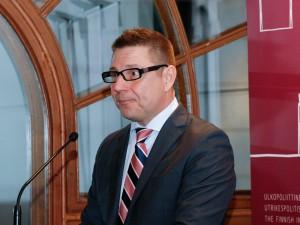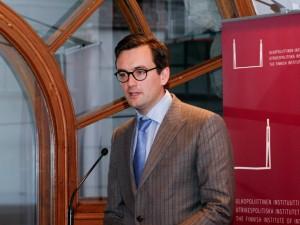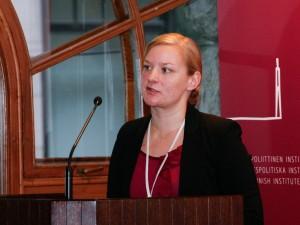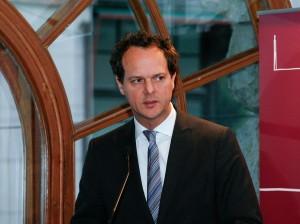The influx of migrants from the Middle East to the European Union has caused a complex crisis that is testing EU capabilities and solidarity among member states. A split has emerged between most Western and several Eastern European member states, with the latter resisting the quotas for the relocation of refugees proposed by the European Commission. Meanwhile, the humanitarian situation of the migrants remains precarious, both in the EU and especially in the Middle East. How has the EU tackled the crisis so far? How deep are the differences among EU member states on the issue? What developments are expected on the ground and in EU policy-making in the coming months?
Opening remarks: Juha Jokela, Programme Director, the Finnish Institute of International Affairs
Speakers: Leonhard den Hertog, Researcher, Centre for European Policy Studies (CEPS)
Andrew Byrne, Correspondent from Budapest, Financial Times
Hanna-Leena Tikkanen, Specialist, Reception of Asylum Seekers, Finnish Red Cross
Wolfgang Mühlberger, Senior Research Fellow,the Finnish Institute of International Affairs
Chair: Marco Siddi, Senior Research Fellow, the Finnish Institute of International Affairs
Summary of the seminar:
Dr. Juha Jokela opened the seminar by stating that already during the planning of the seminar it was clear that early attempts at dealing with the refugee crisis were in trouble. First of all the EU’s efforts were proving not to be the enough in tackling the immediate effects of the crisis. Secondly the EU’s earlier attempts at solving the Syrian crisis were proving inadequate. Thirdly the refugee crisis was proving to be very divisive both internally and externally.
Dr. Marco Siddi stated in his remarks that the current crisis is undoubtedly one of the largest humanitarian crises in recent times, especially in Middle Eastern countries. The growing numbers of refugees are testing EU solidarity, both among member states and towards refugees. So far the EU’s policies seem inadequate. Dr. Siddi argued that the EU and especially eastern member states are suffering from a ”compassion deficit” – a term used by the Bulgarian political scientist Ivan Krastev.
Dr. Den Hertog analysed the humanitarian aspects of the crisis from three perspectives – the departure of the refugees, the journey to Europe and the arrival in Europe. First of all the situation in departure countries like Lebanon and Turkey is highly strained. So far the EU’s main response has been to help these countries through funding but there have been important shortfalls in the funding especially to the UNHCR. Secondly the journey to Europe is extremely dangerous. The EU has responded through stepping up the operations of Frontex, the EU agency facilitating cooperation between member states in external border management, and including search and rescue missions in these operations. However this has created some debate as to the role and mandate of Frontex and also competence struggles between the EU and its member states. The EU has also initiated the Sofia military operation (known also as EUNAVFOR Med) in central Mediterranean. This became a central part of the approach after the April disaster when over 700 migrants drowned near the coast of Libya. The central Mediterranean route to Europe is still important, but some argue that the military operation has shifted the flow of migrants towards the more eastern routes. Dr. Den Hertog stated that neither the military mission nor the common policy in tackling the crisis can function without the member states cooperation. There is also an inherent tension between the humanitarian search and rescue operations and the security dimension of the operations. More emphasis should be put on asking why these journeys are happening in the first place. According to Dr. Den Hertog, one of the most important reasons for refugees taking illegal and dangerous routes to Europe is the lack of legal entry points. The problem for most refugees is not the inability to afford the journey to Europe, but rather the fear of not being able to enter Europe legally. As to the third phase of the refugees’ journey to Europe, Dr. Hertog noted that the problem of several member states is simply being unable or unwilling to set up centres of arrival. For example in Greece, which is one of the most important entry points for refugees coming to Europe, the facilities are rather poor. One of the reasons why many of the refugees do not want to stay in Greece is the inability of Greece to provide adequate reception. The disunity of the EU member states has seen the breaking down of the Dublin system. Several measures have been taken in Brussels. First of all there is the so called hotspot approach, and secondly the internal relocation plan is also part of the Brussels initiative in tackling the crisis. According to Dr. Den Hertog, the underlying rationale of these initiatives is to create a kind of Dublin 2.0 approach with the relocation of the refugees included in this scheme. The hotspots would have the function of registering and fingerprinting the arriving refugees and possibly also screening them for security reasons. However it should be noted that these hotspots are not planned as reception centres, and they do not address the humanitarian crisis.The relocation plan could in turn relieve some of the pressure from Greece and Italy. Another potential approach is the civil protection mechanism, which means that the countries that take part could request very concrete humanitarian material from others. Dr. Den Hertog noted that several countries have already done so but there have also been failures to deliver. According to Dr. Den Hertog, there is a tension between the humanitarian and military logics in responding to the crisis. Another problem is the unwillingness to cooperate in tackling the issue, which leads to a race to the bottom between different countries. The hotspot approach has failed and so has the coordination of the internal EU dimension as well. The recent EU efforts to co-opt third countries – demonstrated by the summits with Africa and Turkey – are examples of trying to stem the flow of refugees there. There have also been increasing initiatives in funding these countries in tackling the situation. However Dr. Den Hertog noted that making this funding conditional on closing borders will only lead to a worsening humanitarian crisis in these third countries. Lastly Dr. Den Hertog presented some concrete steps that could be taken in addressing the humanitarian dimension of the crisis. First of all, more legal entry routes should be set up – this would address the question of smuggling. Secondly, humanitarian visas should be issued so as to make entry possible. It should be noted that these initiatives do not require new EU treaties, but would simply demand that the EU respects its own treaty provisions. Another concrete initiative should be the strengthening of the EU’s asylum authority. Finally it should be noted that if the EU now decides to close its borders this will only make the humanitarian situation worse. The humanitarian situation will be with us for some time.
Mr. Andrew Byrne gave his assessment of the current state of border controls in the Greek-Macedonian border and the political situation affecting the refugee crisis in Eastern and Central Europe and especially Hungary. At the moment the situation on the Greek-Macedonian border in terms of border control measures is so difficult that the Schengen area cannot be considered as functioning. As to the political situation in Hungary, Mr. Byrne argued that Prime Minister Orbán has shaped the discussion on the refugee crisis in Europe as much as Chancellor Merkel, but from a different stance. The anti-refugee attitudes in Central and Eastern Europe are on the rise. At the Greek-Macedonia border the current number of arrivals is 5000-6000 persons/day. Both the security and humanitarian services at this border region are unable to handle these numbers. This leaves the authorities with two options. First there are attempts to register the refugees but this has proven to be nearly impossible. For example in Macedonia there is the lack of adequate facilities such as biometric scanning. The second option is to let the migrants go. However, this is creating controversy among the countries further to the north. There also efforts to increase the fencing along the border regions. For example Hungary has provided Macedonia with razor wire fences. However these are proving to be largely inadequate. Another option is to adopt filtering measures, which means that only certain groups of migrants are allowed to pass. According to Mr. Byrne, these measures have often been taken without informing the humanitarian authorities. The local agencies are ill-equipped to tackle the situation – in this sense the UNHCR is better prepared to address the humanitarian situation. However the situation is made more difficult by the growing numbers of migrants trapped in the border regions. Hungary’s border fence has stemmed the flow of refugees to Hungary somewhat, but on the other hand it has diverted the flow of migrants to other countries. There are also coordination problems between the countries in the region. As to the political situation in Hungary, Mr. Byrne stated that the crisis has increased the support of Prime Minister Orbán’s anti-refugee policies. A year ago Prime Minister Orbán was more vulnerable to criticism. According to publicity ratings he is at the moment the most popular Prime Minister in Hungary since the end of the Cold War.The policy shift to a security emphasis in tackling the refugee crisis has led the public to consider the crisis in terms of security. The current public discourse is focusing on linking migration and terrorism and characterising the migrants as invading Europe. There are also claims that terrorists are being smuggled into Europe among the refugees. In Hungary there is a petition of over a million signatures to oppose the EU relocation plan. Much of the public discourse is framing the situation as a European attack on national sovereignty. The refugee crisis is framed as a leftist liberal conspiracy where Muslims are being smuggled into Europe to support social democrats. In conclusion, Mr. Byrne stated that it seems that the group of hard-core anti-immigrant and anti-refugee countries has grown and the more liberal western group has declined. The anti-immigrant group currently includes the Visegrád countries and Romania. The new Polish Government has also embraced anti-immigrant and anti-refugee attitudes. This means in practice that the current quota system of the EU may not work in this setting. It is hard to relocate the refugees since many refugees do not want to go to Central and East European Countries and these countries do not want to take them in. The new EU proposal of creating border control forces reflects the growing securitisation of the refugee crisis. At the moment we are witnessing a broader reframing of the principles of asylum policy in the EU. In Hungary, Prime Minister Orbán is rejecting the idea that the EU has a responsibility to tackle the issue. The paradigm of multiculturalism has been profoundly challenged.
Ms. Anna-Leena Tikkanen introduced the actions of the Finnish Red Cross (FRC) in tackling the refugee crisis in Finland. At the moment the number of people applying for asylum in Finland is estimated at between 30000 and 35000 people. The asylum seekers are coming to Finland mainly from Iraq and Afghanistan. The role of the Finnish Red Cross is to work as an auxiliary to Finnish Authorities. The organisation provides accommodation, basic medical care, protection and shelter to the migrants. The registration centre in Tornio is a good example of this kind of approach. In Finland the cooperation between different authorities – the national police, the border control authorities, the Finnish immigration service and the Red Cross – is working fairly well. The role of the FRC is to provide basic services to the refugees and to help in restoring family links. The refugee crisis caught the Finnish authorities at unawares. In September there were only 6 housing units for the asylum seekers, whereas at the moment there are in total 100 units. The FRC handles around 60% of the activities of these units.The FRC has recalled a number of its workers from abroad to help tackle the situation but the organisation’s volunteers are also a key factor in handling the crisis. At the moment there are over 8000 volunteers at the refugee units. The FRC is utilising its international aid reserve to tackle the situation. The media coverage on the actions of the Finnish Red Cross has been quite neutral so far. The organisation is also helping in integrating the asylum seekers into Finland.
Mr. Wolfgang Mühlberger stated that one of the underlying causes of the refugee crisis are the civil war and collapsing states in the Middle East. In the region, tackling the crisis concerns to a large extent the regional distribution of the refugees. However, one should keep in mind that there is a potential role for the diaspora in a potential post-conflict reconstruction. At the moment the Syrian refugee population in Turkey is over 2 million people, in Lebanon over 1 million, in Jordan over 600 000, in Iraq over 244 000 and in Egypt over 120 000. There are in addition around 7.6 million internally displaced persons inside Syria. Hence, the Syrian refugee population corresponds to almost half of the entire Syrian population. According to Mr. Mühlberger the refugees have to choose between the camps and the close-by urban areas. Within the camps there are some very basic services but basically no professional opportunities. These are better available in the nearby cities, or regional capitals (Amman, etc). As to the countries affected, in Turkey there are recent legal steps to include refugees into the job market. Lebanon has also been able to handle the situation in a relatively peaceful way. There are 1.1 million registered refugees in Lebanon. This is the highest ratio of nationals to refugees in the countries of the region. One particular feature of Lebanon in tackling the crisis is that there are no camps, nor state support. Rather the refugees are taken in by individual households and the distribution of the refugees runs largely along confessional lines. However, even in Lebanon the limits of hospitality are being reached. In Jordan the situation is extremely well organized. However there seems to be a gradual, voluntary withdrawal from the refugee camps (e.g. Zaatari camp population was almost halved in 2015). According to Mr. Mühlberger this is mainly due to the fact that the cities are more attractive in terms of employment. There have been over 4 million refugees in total since 2011 in the region. This group includes over one million children which is an extremely vulnerable group in humanitarian terms. One of the current challenges is that in the neighbouring countries there is the potential for conflict that is caused by the influx of refugees. At the moment ISIS is challenging the national borders that are based on the Sykes-Picot system which is also functioning as a security system. In conclusion Mr. Mühlberger stated that this situation is likely to continue for some time. Any future settlement of the situation in Syria has to take into account important regional players and Iran should be part of any solution to this conflict.






